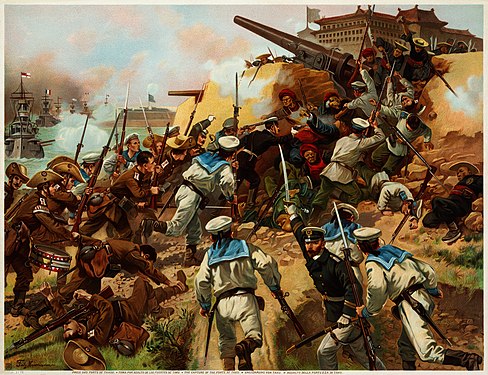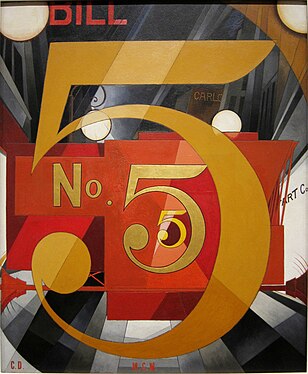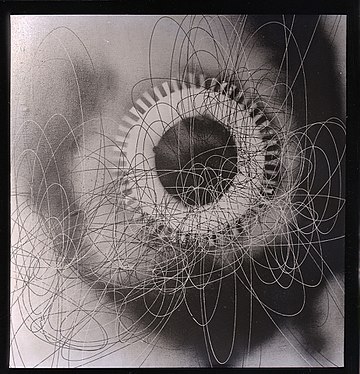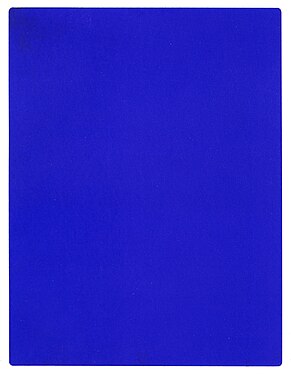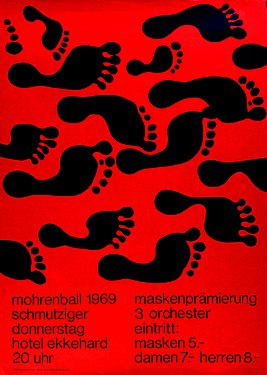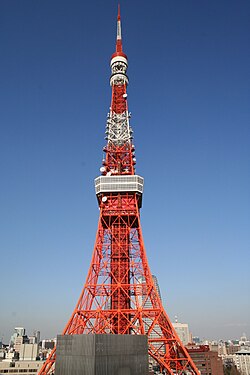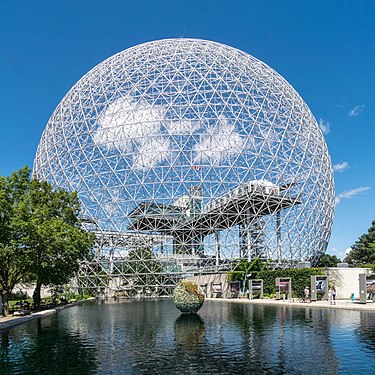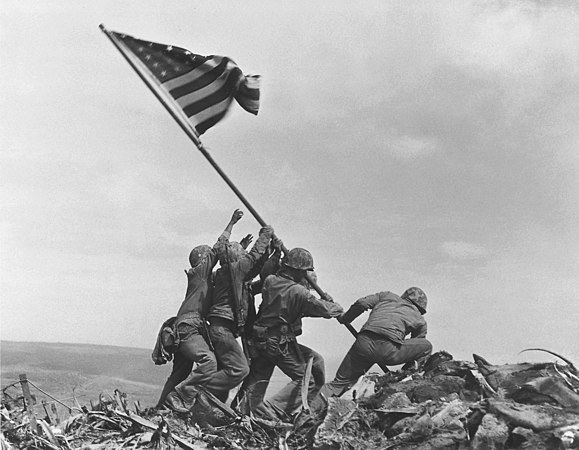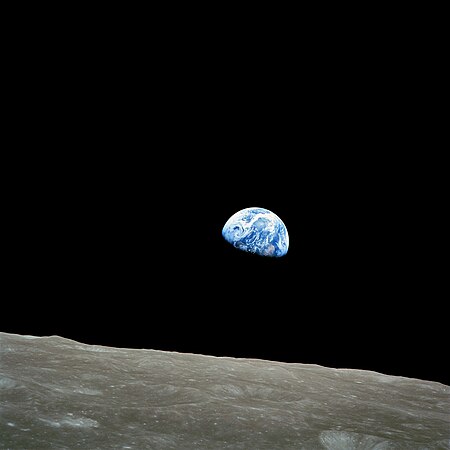Art History/20th Century
The twentieth century has seen huge changes in the modes and meanings of artistic production that mirror the enormous social changes that have occurred during the same time period. Continuing with the break with the academic values such as the hierarchy of genres, many movements and many countries re-evaluated aesthetics, technique, color, media, meaning, and many other aspects of artistic enterprise. Technology has had not only an indirect impact on artists, but often is the subject matter, or even the media that artists have worked with.
The Impressionists, at the end of the nineteenth century, who championed landscape painting and revolutionized technique and use of color, helped to open the floodgates for many more movements (not all of which identified themselves as such). The Secession movement, Fauvism, Cubism, Expressionism, Dada, The Bauhaus, Futurism, Surrealism, Suprematism, De Stijl, Abstract Expressionism, Pop Art, Op Art, Minimalism, and the Postmodern are some of the major movements that have shaped the century and changed our very conceptions of what art is.
Secessionist movement
[edit | edit source]
The Secessionist movement was the Austrian branch of a larger movement known primarily as Art Nouveau ("new art"). Depending on the country, the style is also known as Jugendstil (Germany), Style Liberty (Italy), Modernisme (Spain), or Latvian Romanticism. Art Nouveau is an umbrella term but also refers to works of this style produced in France and Belgium. Art Nouveau has its roots in the English Arts and Crafts movement of the 19th century; in fact, certain artists, like Charles Rennie Mackintosh, work in both styles. The purpose of Art Nouveau was to create what is known as a complete work of art - a work that includes painting, drawing and printmaking as well as applied arts and architecture. For this reason, some of the most beautiful and informative Art Nouveau works are complete rooms or houses where every object within is executed in Art Nouveau style. Art Nouveau is characterized by free-flowing floral, vegetal, and other typically feminine motifs. It also features a kind of romantic mysticism that can be traced back to the Pre-Raphaelite and Symbolist movements of the 19th century. Some well-known Art Nouveau artists and craftsmen include Alphonse Mucha (Czech), an accomplished printmaker and painter; Antoni Gaudi (Spanish), whose architectural works dot Barcelona; Hector Guimard (French), whose wrought-iron entrances for the Paris metro have become his legacy; Gustav Klimt (Austrian), who led the Austrian Secessionists with his opulent and complex paintings; and Louis Comfort Tiffany (American), who is well-known for his distinctive stained-glass work.
Fauvism
[edit | edit source]
Fauvism, whose name derives from the French word for "wild beast," was a Primitivist movement centered in Paris in the first decade of the 20th century. The most well-known Fauvist artists are Henri Matisse and Andre Derain. The large blocks of color and simplified forms Fauvist artists used undoubtedly influenced the Cubist movement, which overlapped Fauvism by a few years.
Cubism
[edit | edit source]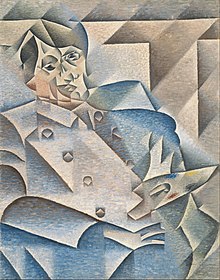
The Father of Cubism is said to be Cezanne. Pablo Picasso, a Spanish artist, who had many phases in his long career, picked up the gauntlet of Cubism. His famous "Demoiselles d'Avignon" of 1907, housed in the Museum of Modern Art in New York, depicts five nude women, possibly prostitutes, in an interior. The painting is primitivistic - Picasso synthesized his well-documented interest in African masks into the faces of the figures. The fragmentation and flattening of the figures also anticipates the development of analytical Cubism a few years later. One of the Spaniard's most socio-political cubist paintings is "Guernica" of 1937, his grey, black and white portrait of the horrors of war. The basque town of Guernica was bombed by the German Luftwaffe on April 26, 1937.[1]
Another founding member of the Cubist movement was Georges Braque, a French artist whose analytical Cubist work from the 1910s is quite similar to Picasso's. Braque and Picasso worked together closely, and Braque's influence on Picasso (and vice versa) should not be downplayed. Other major artists of the analytical Cubist movement include Juan Gris, whose interest in mathematics made his art more regularized, and less fragmented, than Picasso's; Marcel Duchamp, whose early, pre-readymade works such as "Nude Descending a Staircase" are highly fragmented and undeniably Cubist; Jean Metzinger; and Albert Gleizes.
Dadaism
[edit | edit source]
Dadaism was a German-French-American movement of the 1920s up to the 1960s which was a reaction to the horrors of World War I; it incorporated wordplay (largely nonsensical) and collage. It was founded by the poet and playwright Tristan Tzara in the Cabaret Voltaire, France. Major members included Francis Picabia, Hugo Ball, Hannah Höch, and Marcel Duchamp.
Futurism
[edit | edit source]Futurism was an Italian movement in the 1910s and 1920s that was based on a fascination with movement, technology, and machinery. Major members included the founder Filippo Marinetti (Zang Tumb Tumb; poem), Umbertro Boccioni (Unique Forms of Continuity in Space; sculpture) and Giacomo Balla (Dynamism of a Dog on a Leash; painting), the latter two both painters and sculptors.
Vorticism
[edit | edit source]
Vorticism was an English movement of the 1910s; it was founded by writer and painter Wyndham Lewis as a reaction to Futurism.
The movement officially began in 1914, in the first issue of literary magazine BLAST, but ended after the main members witnessed (or died in) World War I. The war painter Christopher Richard Wynne Nevinson was briefly involved, but was later expelled from the group and became identified as a Futurist. Sculptor Jacob Epstein was not formally involved, but his Torso in Metal from Rock Drill is regarded as a major Vorticist work.
Major members included David Bomberg (The Mud Bath; painting), Edward Wadsworth (Dazzle-ships in Drydock at Liverpool; painting), Henri Gaudier-Brzeska (Vortex (written from the trenches); essay) and Ezra Pound (Vortex; essay).
Postmodernism
[edit | edit source]Postmodern artist Barbara Kruger is known for critical images inspired by commercial advertising. She is the author of several books. "Love for Sale" shows Kruger's blown up photographic black and white images with text in a red box superimposed creating a new meaning for the viewer. Kruger taught at the Art Institute and Cal Arts during the 70s. Kruger's work often focuses on feminist issues. Kruger's Whitney Biennial 2'x3' work, enlarged as she tackled billboards in the US and other countries.
She was the subject of a lecture given at the 3rd Annual Conference of the Society of the Word and Image at Carleton University in Ontario, Canada in 1993.
Abstract Expressionism
[edit | edit source]A school of painting that flourished after World War II until the early 1960s, characterized by the view that art is nonrepresentational and chiefly improvisational.
Abstract art is defined as art that has no reference to any figurative reality. In its wider definition the term describes art that depicts real forms in a simplified or rather reduced way - keeping only an allusion of the original natural subject. The abstract paintings of Joan Miró are a good example of this wider definition. The term non-figurative is used as a synonym.
In the twentieth century Wassily Kandinsky is considered as the inventor of non-figurative art. Over a period of several years his paintings moved gradually away from figurative subjects. In 1910 he created the first completely abstract work of art - a watercolor - without any reference to reality. Wassily Kandinsky not only became the first abstract artist, he also promoted it as a theorist. In 1912 his book On the Spiritual in Art was published.
A movement of abstract painting that emerged in New York City during the mid-1940s and attained singular prominence in American art in the following decade; also called action painting and the New York school. Jackson Pollock 's turbulent yet elegant abstract paintings, which were created by spattering paint on huge canvases placed on the floor, brought abstract expressionism before a hostile public. Willem de Kooning 's first one-man show in 1948 established him as a highly influential artist. Other important artists involved with the movement included Hans Hofmann , Robert Motherwell , and Mark Rothko ; among other major abstract expressionists were such painters as Clyfford Still , Theodoros Stamos, Adolph Gottlieb, Helen Frankenthaler, Lee Krasner, and Esteban Vicente.
20th Century Art Gallery
[edit | edit source]1900-1920
[edit | edit source]-
The Capture of the Forts at Taku by Fritz Neumann (Between 1900 and 1919)
-
Portrait of Adele Bloch-Bauer I by Gustav Klimt - 1907.
-
Simultaneous Windows on the City Abstract Cubist painting by Robert Delaunay - 1912.
-
Portrait of Wally Neuzil by Egon Schiele - 1912.
-
Slavs in their Original Homeland: Between the Turanian Whip and the Sword of the Goths by Alphonse Mucha - 1912
-
The Virgin by Gustav Klimt - 1913
-
Painting No. 48. by Marsden Hartley - 1913. An example of American Modernism.
-
Form and Light, Motif in West New Jersey by Oscar Florianus Bluemner - 1914. An example of American Modernism.
-
Portrait of a German Officer by Marsden Hartley - 1914. An example of American Modernism.
-
Vorticist Study by Edward Wadsworth - 1914
-
Spirit of Communications Bronze statue by Evelyn Beatrice Longman - 1914-1916.
-
Black Square by Kazimir Malevich - 1915.
-
Interior of a Studio by Sigrid Hjertén - 1916
-
Bermuda No. 2, The Schooner Cubist and Futurist art by Charles Demuth - 1917.
-
Fountain by Marcel Duchamp - 1917.
-
Synchromy No. 3 by Stanton Macdonald-Wright - 1917. An example of Synchromism.
1920-1945
[edit | edit source]-
Abraham Lincoln Marble statue by Daniel Chester French - 1920.
-
Asbury Park South by Florine Stettheimer - 1920. An example of Jazz Age inspired artwork.
-
Bauhausausstellung Bauhaus style by Joost Schmidt - 1923.
-
On White II by Vassily Kandinsky - 1923.
-
I Saw the Figure 5 in Gold Cubist and Futurist art by Charles Demuth - 1928.
-
American Gothic Social Realism painting by Grant Wood - 1930.
-
The Slav Epic Poster by Alfons Mucha - 1930
-
Makeup through the Window by Harue Koga - 1930. An example of Japanese surrealism.
-
Christ the Redeemer statue - 1931.
-
4 of 8 Guardians of Traffic art deco sculptures by Henry Hering and Frank Walker ~ 1932.
-
Chicago World's Fair art deco poster - 1933.
-
Workers Sorting the Mail Art Deco mural by Reginald Marsh - 1936.
-
Nighthawks by Edward Hopper - 1942.
1945-1970
[edit | edit source]-
spiralis by Roberto Crippa - 1953. An example of Spatialism.
-
Jazz by Ernani Costantini - 1956.
-
Spirit of Detroit bronze statue by Marshall Fredericks - 1958.
-
Welcome to Fabulous Las Vegas sign, an iconic example of Googie style - 1959.
-
Picture by Drawing Machine 1, by Desmond Paul Henry - 1962.
-
Miriam Laufer with paining in 1962.
-
IKB 191 Minimalist work by Yves Klein - 1962
-
David Smith, Cubi VI - 1963.
-
Our Life, an East German mural in the social realism style - 1964.
-
Leyendo las noticias by Marta Minujín - 1965. An example of Happening performance art.
-
Who's Afraid of Red, Yellow, and Blue I Minimalist artwork by Barnett Newman - 1966.
-
Poster in the International Typographical Style - 1969.
1970-1999
[edit | edit source]-
The Rainbow by Salvador Dali - 1972.
-
AA78 a painting in the Fantastic Realism style by Zdzisław Beksiński - 1978.
-
Meteorite by Milton Becerra - 1985. An example of the "Land Art" style.
-
Rite of Spring by Ronnie Landfield - 1985. An example of the Color field style of abstract painting.
-
Homage to Newton, a surrealist sculpture by Salvador Dali - 1985.
Architecture
[edit | edit source]-
Porte Dauphine station of the Paris Métro, an Art Nouveau building - 1900.
-
Moana Hotel - 1901.
-
Sacré-Cœur- 1919.
-
Empire State Building Art deco architecture - 1931.
-
Cincinnati Union Terminal Art Deco train station - 1933.
-
Frank Loyd Wright sketches for Broadacre City.
-
Golden Gate Bridge Art Deco bridge - 1937.
-
Jefferson Memorial - 1943.
-
Tokyo Tower - 1958.
-
Solomon R. Guggenheim Museum Modern architecture by Frank Loyd Wright - 1959.
-
Space Needle - 1961.
-
Theme Building - 1961.
-
Montreal Biosphere - 1967.
-
Gateway Arch - 1967.
-
Cathedral of Brasília - 1970.
-
World Trade Center New Formalism architecture - 1973.
-
Sydney Opera House Modernist expressionist architecture - 1973.
-
Willis Tower/Sears Tower International architectural style - 1974.
-
Olympic Stadium in Montréal - 1970's-1980's.
-
Bank of China Tower - 1990.
-
Petronas Towers Postmodern Islamic Architecture - 1999.
Photography
[edit | edit source]-
Early high quality color photograph - 1911.
-
Lunch atop a Skyscraper - 1932.
-
Migrant Mother by Dorothea Lange - 1936.
-
Hindenburg disaster - 1937.
-
Raising the Flag on Iwo Jima - 1945.
-
Raising a flag over the Reichstag - 1945.
-
Guerrillero Heroico - 1960.
-
Earthrise - 1968
-
Buzz Aldrin on the Moon - 1969.
-
Blue Marble - 1972.
-
Pillars of Creation - 1995.
Film
[edit | edit source]-
A Trip to the Moon, a film directed by Georges Méliès - 1902.
-
The Great Train Robbery - 1903.
-
Gertie the Dinosaur - 1914
-
The Bond - 1918.
-
Feline Follies - 1919.
-
Manhatta by Paul Strand - 1921. The 20th century saw photography and videography take great advances in artistic expression.
-
The General - 1926.
-
Don Juan introduced synchronized recording music with film - 1926.
-
The Fifth-Column Mouse an example of a wartime propaganda film - 1943.

